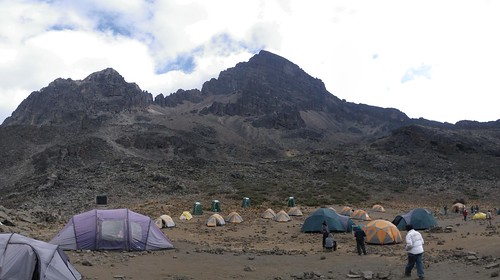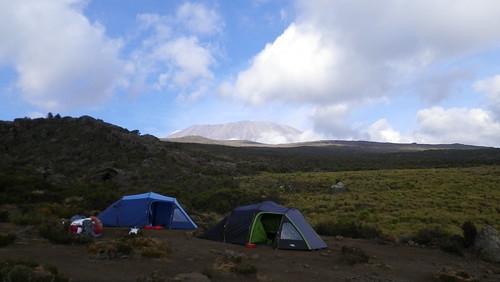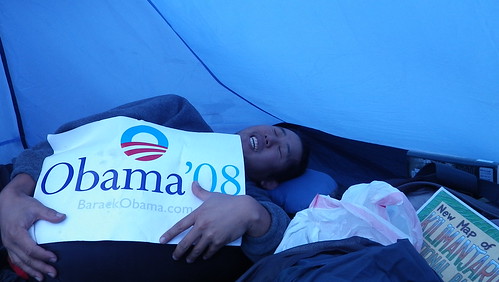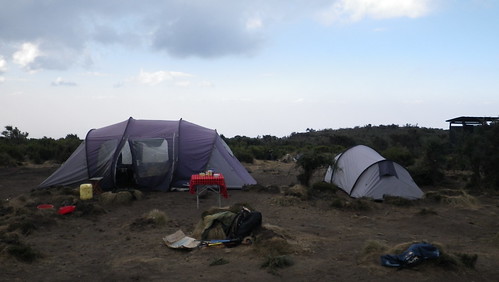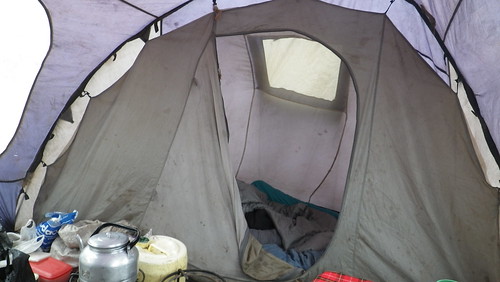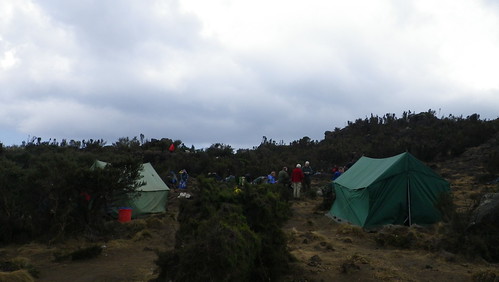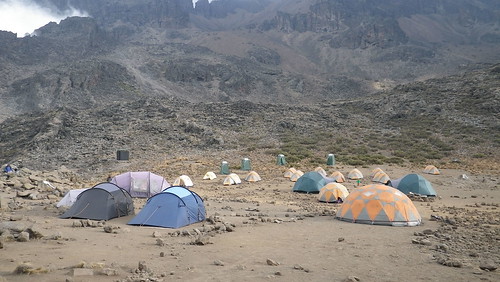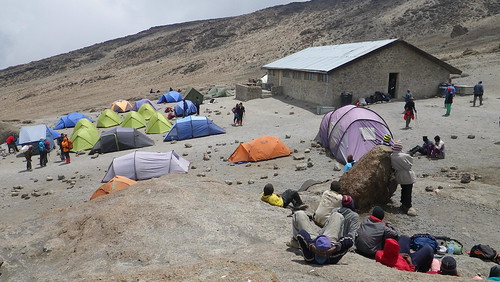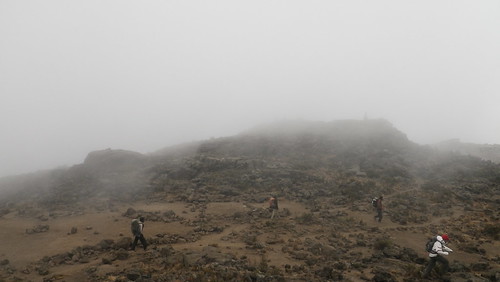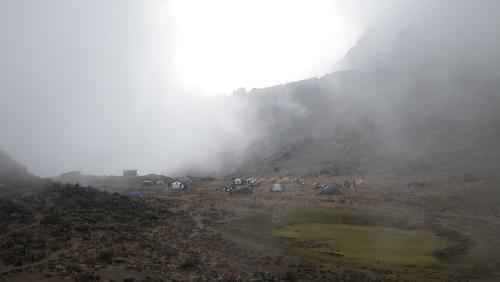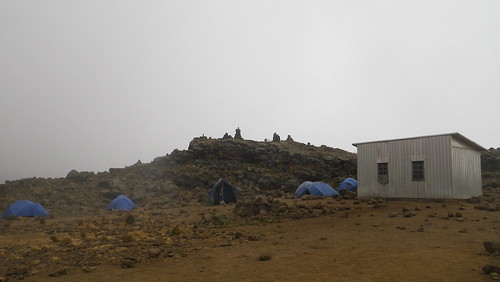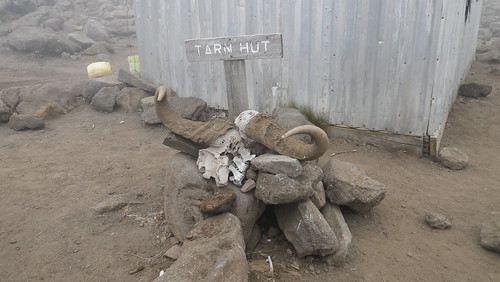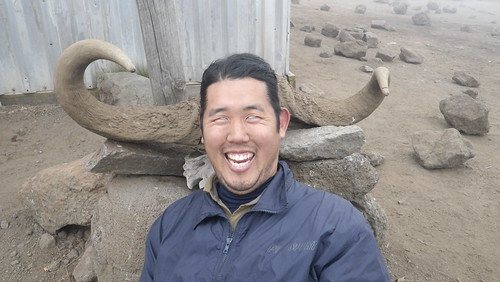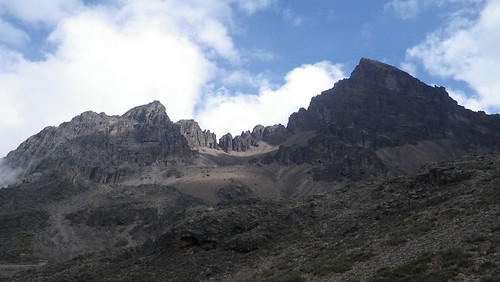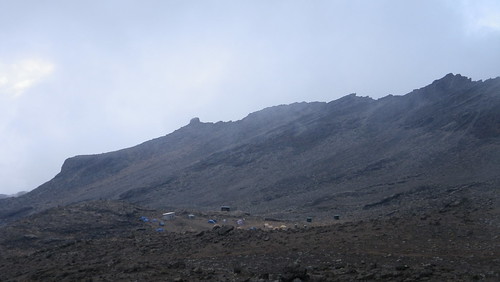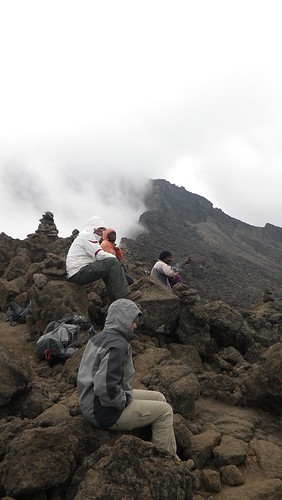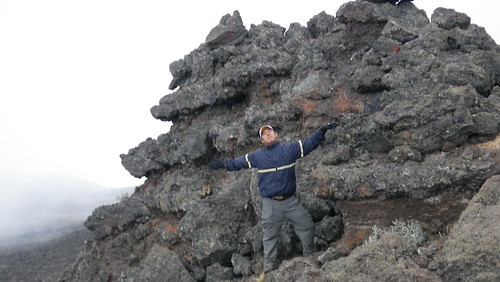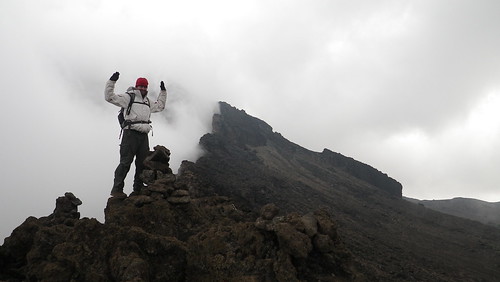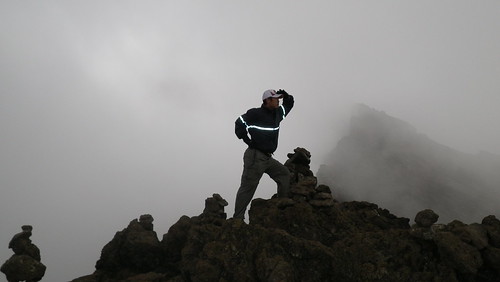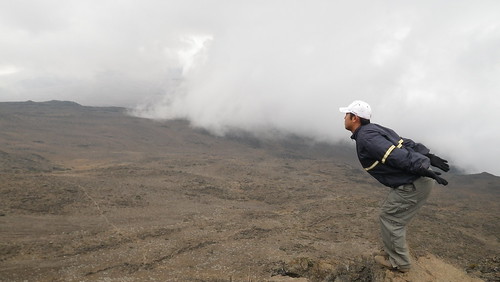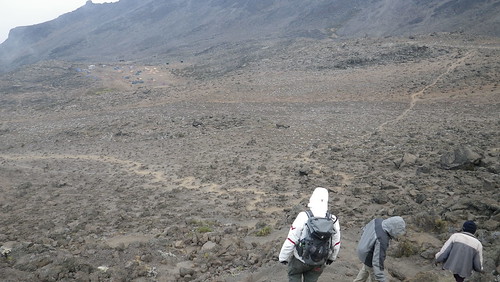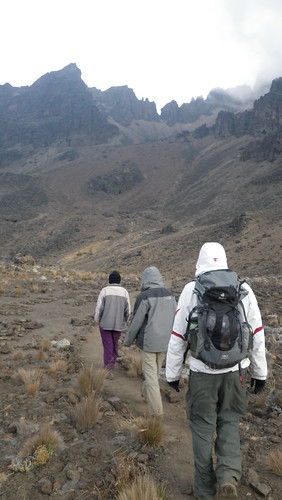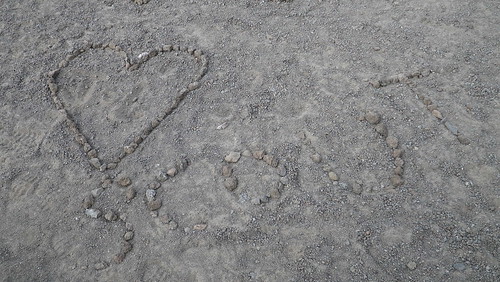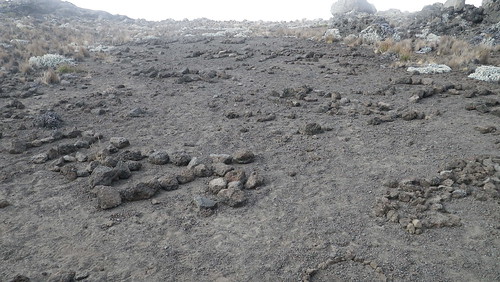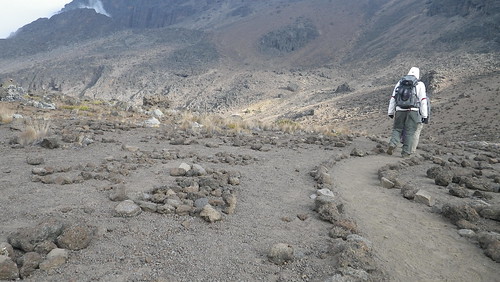... and my thoughts on KPAP/IMEC as applied to Maasai Wanderings, which I went over in one of my previous posts.
Before I get to "Mawenzi in the Morning" below, a shout out to Ginger's blog, as I spent all-weekend with her, and 18 of our closest friends, on the ocean-side beach of Assateague Island camping among the horses.

Anyways, above is the peak of Mawenzi, in a rare moment in the early morning when it is without clouds. It's jagged peaks were great. But before we get into that, a word about our porters, which caused us so much consternation before the trip to get the ethics right.
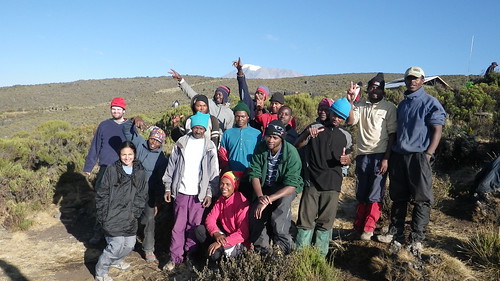
Below is our crew, with Resha and William on the left. The names of the people on our crew are below. Briefly:
- (1) Ronald, our head guide, is in the middle wearing a green overshirt and a black knit hat;
- (2) Jonas, our second guide, is to the left of Ronald wearing the flourescent blue hat;
- (3) Goodluck, our cook, is squatting in between Ronald and Jonas and wearing the pink jacket;
- (4) Modi, our waiter, is the guy on the right giving the peace sign;
- (5) Goblisten, our tent captain, is the guy who is kind of tilted in the black jacket and standing to the right of Ronald - he really liked William after William taught him the grenade handshake;
- (6) Goblining, our dish washer, is the guy on the far right with the blue jacket and beige hat; and
- (7) Samuel is the guy wearing the blue-green shirt and green hat in the middle - he is "just a porter," but he was also the guy I practiced my rudimentary Swahili with, particularly counting. The number 30 gave me the most problems.

Now, of course the porters have a difficult job since they have to carry all of our crap, their own crap, and generally camping crap all the way up and down the mountain. And like in the movies, most of them liked carrying it on their heads for balance, as seen below. Despite these big loads on their head, however, they left us in the dust when it came to climbing.
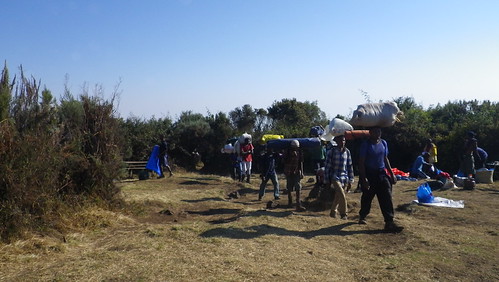
You can see some of the porters in front of us in the below photo, but rest-assured, verticalness was no obstacle for most of these guys.

Below they are in a string dotting the landscape around us.
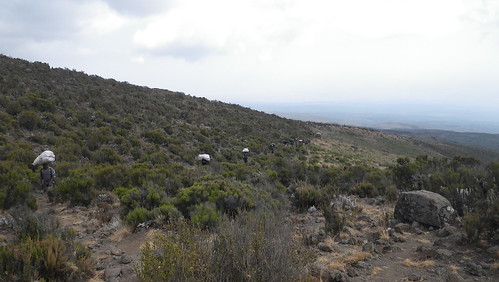
And below is a brief video of them as they passed us with stuff walking through the clouds. Impressive, aye?
Of course, however, these guys get tired, so we sometimes did pass them on the way up, particularly on the longer days. But never did we pass one of our crew... it was always another crew.
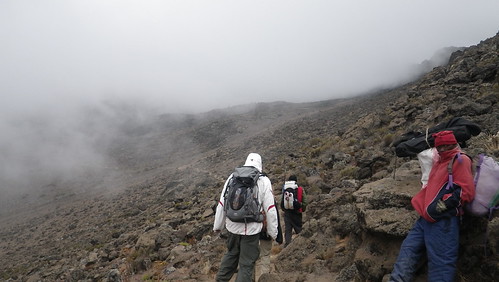
So what did they carry? Well, first there was our stuff. Every morning, we packed our own stuff and brought it out for re-packing by the porters into waterproof satchels. Below is the combination of the packs we were going to carry on our backs, and the stuff they would carry.
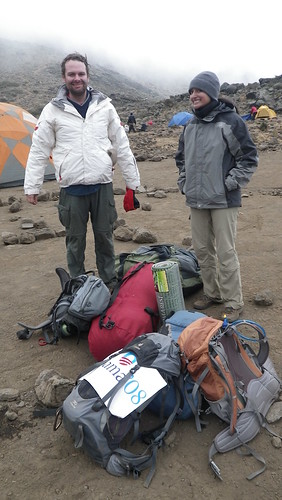
Here they are packing into the waterproof bags for easier grip and handling.
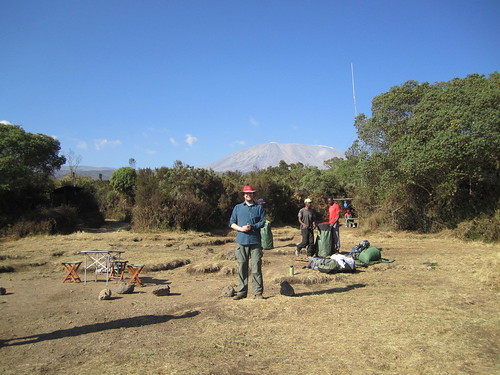
There was also general camp stuff they had to carry. Like I said in a previous post, the heaviest things to carry were the propane tanks, which were carried in wicker baskets. There was sort of a draft system on who would carry what, and, of course, the younger guys usually ended up getting stuck with these. The other cooking equipment usually ended up in another basket, and each of the tents ended up in their own bags.
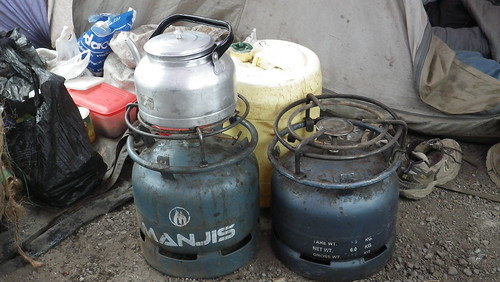
The most interesting item carried, however, are the yellow jugs shown above and below. Those were for our water. Now, a little bit about the water. On most days, we would camp near a source of water, usually a stream, so getting water was pretty easy. We never got sick from the water, as the guys were very careful to boil everything, and then send it through a filter. While it did retain a little bit of Kilimanjaro's red dirt color, it tasted fine, and like I said, we didn't get sick.
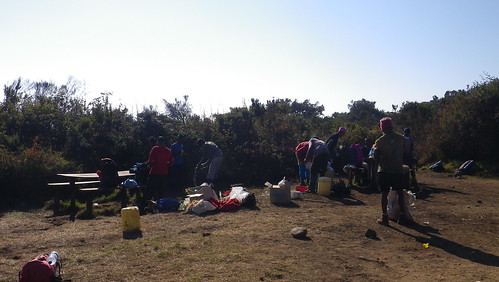
Some of the sources of water were stagnant...

... others flowed mightily in wetter seasons...
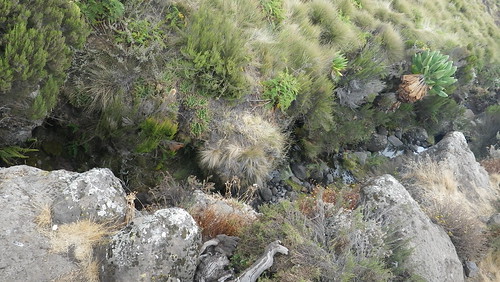
... and some of it you had to dig for.
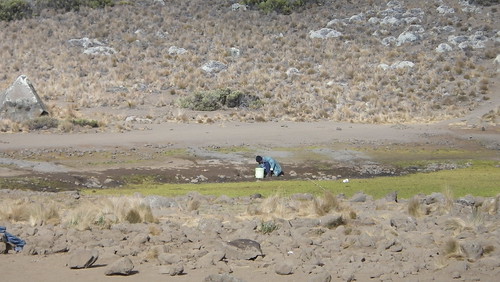
Actually, however, both Ronald and Jonas said that at Mawenzi, while you could dig into the pond to get water several feet down, it wasn't enough, and so at Mawenzi, some guys actually had to go down to the last stream we passed to get water with the yellow jugs shown above. Now THATS a tough journey, as sometimes it was a good mile or two back down the trail. We wished everyone godspeed who did that.
This wasn't a problem once we reached the huts, as they had running tap water there. Even then, however, you couldn't directly drink the water, which came into consideration on the last day, as I will detail in a future post.
So anyways, as far as KPAP/IMEC went, here were my evaluations of their "myths debunked" concerning porters of Maasai Wanderings:
- MYTH #1:THERE IS A MININUM WAGE THAT COMPANIES ARE REQUIRED TO PAY ALL PORTERS CLIMBING KILI.
- The Kilimanjaro National Park and the Tanzania Association of Tour Operators have established 6,000Tsh per day on the Marangu Route and 8,000Tsh per day on all of the other camping routes as the wage for porters. A typical wage for a porter is 4,500Tsh per day. Because some money is better than no money, porters will accept the work, but this pay does not add up to a living wage.
I actually snuck a peak at the pay sheet for everyone at the end of the last day, and Maasai Wanderings paid their porters a minimum of 10,000Tsh per day. So that's good.
- MYTH #2: PORTERS EAT THE SAME QUALITY MEALS AS CLIMBERS DO.
- Porters often eat just one meal at the end of each day, primarily a local corn-porridge called "Ugali".
It is true that the porters did not eat with us, and that they did seem to eat a good bit of Ugali. As detailed in one of my previous posts, however, since most of them preferred not to eat what we ate (and not literally our leftovers off our plates, which would be gross, but just extra food we were not served), I think they ate okay. I don't know exactly how many meals they ate, but I got the impression most of them didn't eat lunch, as on our trek when we had box lunches, our guides always ran off somewhere else, and left us to eat in peace. This was not true during the safari. David always ate with us there.
- MYTH #3: PORTERS HAVE A CONTRACT WITH THE COMPANY THEY ARE WORKING FOR.
- Seldom is there an official contract for working as a porter. A company employs the guide who then is responsible for hiring the porters. Porters can even be taken into service the morning of the climb itself. And many companies hold no responsibility for the porter if he should become ill while climbing.
I am sure this is true for the porters. Ronald and Goodluck were clearly the managers on the trek and put together their own teams, so they may have had contracts. Ronald did get a bit ill on the trek (head coldish), so Jonas took over a lot of the lead guide duties, particularly closer to the summit. I insisted he get himself looked at, but I am assuming the prospect of losing a pay day deterred him. So, I did the next best thing giving him pretty much every drug that I had, and he did end up getting quite a bit a rest. By the last day, it seemed to work pretty well.
On one of the days, Ronald came up and asked us if we had any extra Diamox, as a porter in another group was suffering from altitude. Luckily, I did have one extra, which I gladly parted with. Don't know what happened to the guy otherwise.
- MYTH #4: IT IS EASY FOR A PORTER TO CLIMB MOUNT KILIMANJARO.
- Climbing Kili is just as hard work for porters as it is for climbers and they are carrying at least 25 kg (55 lbs) of luggage including their own gear. The Kilimanjaro National Park recommends that a porter carry 20 kg for the company but the average reported weight is 23 kg and can be as high as 30 kg.
This really depended on the individual. For the most part, the guys carried everything to their destinations with little problems in what I considered record-time. Some of them even ran. The most amazing thing I saw in this regard was when I was at the crater rim, and I watched these guys with packs jump over the top of the rim into view, and then skip from rock to rock on the way down. Amazing.
And as I also detailed in previous posts, it seems the people around Kilimanjaro do have some economic choice in becoming a porter, as both David and one of the drivers for Maasai Wanderings did stints as porters, but hated it, and so moved on to other things. Of course, their English is also more developed, so I guess they had better options.
I will say, however, that our bags were probably not weight compliant. Or at least William's was not. He may have well have stuffed a dead body in there. Still, everyone did carry their own equipment backpacks, and looked to be reasonably clothed in warm and wicking wear, as shown in the group photo above.
- MYTH #5: YOUR TIP WILL BE DISTRIBUTED FAIRLY TO THE PORTERS IF YOU GIVE IT TO THE GUIDE.
- KPAP receives many reports that when tips are not handed directly to the porters they may receive only a portion of the amount that was intended for them.
The reviews for Maasai Wanderings were true to its word, in that we were never, ever asked for tips by the porters. The only time we were asked for tips was by Ronald on our last night, when he gave us a list of names for the entire crew (shown above), and insisted that we pay each porter's tip directly to him. I will cover that in a future post as well.
- MYTH #6: PORTERS ARE PROVIDED WITH PROPER SLEEPING ACCOMMODATIONS.
- Porters are often overcrowded in the huts and tents. On the camping routes they may have to sleep in the mess tent which means they must wait, sometimes in inclement weather, until all climbers are finished with their meals.
As I detailed in last week's post, the porters seemed to have adequate, albeit lightly cramped accommodations. And while many did sleep in the mess tent, because the sleeping quarters were in the ends of the mess tent, they didn't have to wait for us to finish outside in the elements. And they definitely were not as, especially on the more difficult days, we could see and hear them sleeping as we ate, even during lunch. So I guess it is hard being a porter.
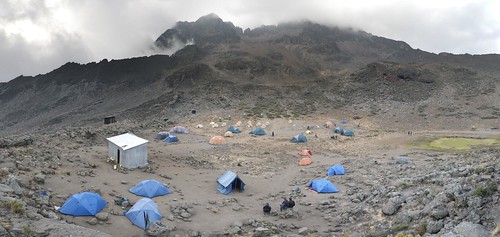
The above panorama is my favorite shot on the entire trek, where you get a sense of perspective of just how small we are in the face of the mountain.
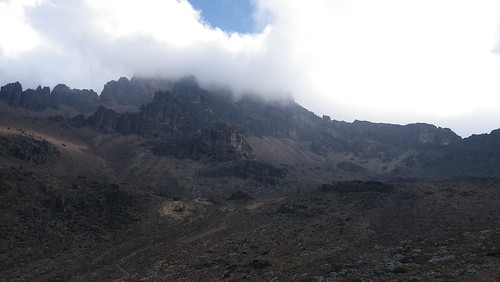
These sequence of shots is in the span of literally minutes. Yes, the clouds moved that fast.
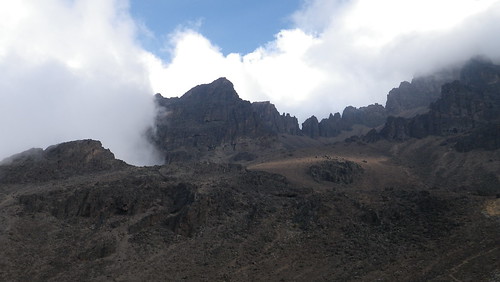
And as on our trek the previous day, the clouds would run into barriers and be redirected up, creating very different climate/moisture zones.

The below is a panorama in the morning looking north toward Kenya, and the path we trekked up the mountain.

A panorama of the clearest view of Mawenzi we got.
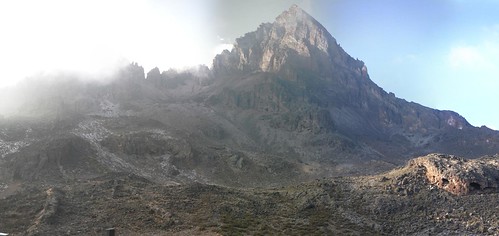
Our tents we dew as the sun rises over Mawenzi.
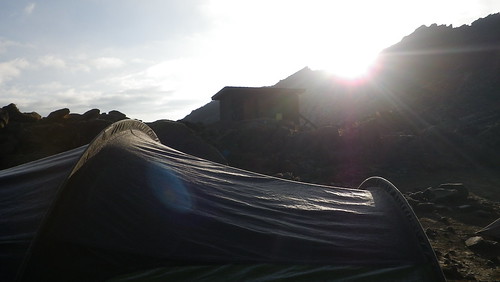
Had to break out Obama in the African sun.

And Barack-O in the shadow of a clear Mawenzi.
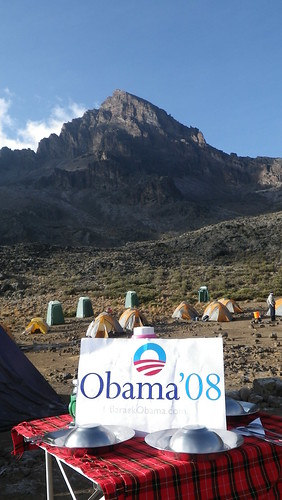
Me psyched to bring the Barry's essence back to his "motherland."

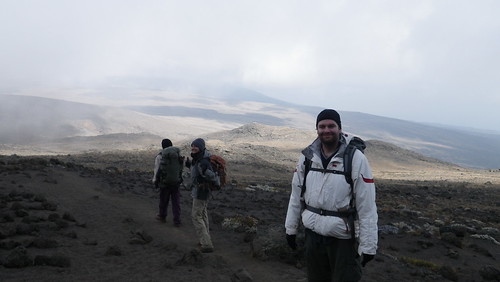
Until next week...
